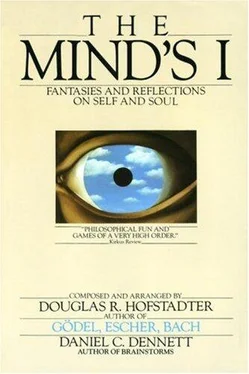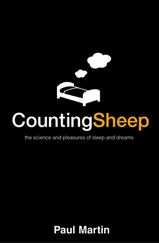PAT: The example may be extreme, but it makes my point that there is a vast difference between a real phenomenon and any simulation of it. This is so for hurricanes, and even more so for human thought.
SANDY: Look, I don’t want to get too tangled up in this line of argument, but let me try out one more example. If you were a radio ham listening to another ham broadcasting in Morse code and you were responding in Morse code, would it sound funny to you to refer to “the person at the other end”?
PAT: No, that would sound okay, although the existence of a person at the other end would be an assumption.
SANDY: Yes, but you wouldn’t be likely to go back and check it out. You’re prepared to recognize personhood through those rather unusual channels. You don’t have to see a human body or hear a voice—all you need is a rather abstract manifestation—a code, as it were. What I’m getting at is this. To “see” the person behind the dits and dahs, you have to be willing to do some decoding, some interpretation. It’s not direct perception, it’s indirect. You have to peel off a layer or two, to find the reality hidden in there. You put on your “radio-ham’s glasses” to “see” the person behind the buzzes. Just the same with the simulated hurricane! You don’t see it darkening the machine room—you have to decode the machine’s memory. You have to put on a special “memory-decoding glasses.” Then what you see is a hurricane!
PAT: Oh, ho, ho! Talk about fast ones—wait a minute! In the case of the shortwave radio, there’s a real person out there, somewhere in the Fiji Islands or wherever. My decoding act as I sit by my radio simply reveals that that person exists. It’s like seeing a shadow and concluding there’s an object out there, casting it. One doesn’t confuse the shadow with the object, however! And with the hurricane there’s no real hurricane behind the scenes, making the computer follow its patterns. No, what you have is just a shadow hurricane without any genuine hurricane. I just refuse to confuse shadows with reality.
SANDY: All right. I don’t want to drive this point into the ground. I even admit it is pretty silly to say a simulated hurricane is a hurricane. But I wanted to point out that it’s not as silly as you might think at first blush. And when you turn to simulated thought, you’ve got a very different matter on your hands from simulated hurricanes.
PAT: I don’t see why. A brainstorm sounds to me like a mental hurricane. But seriously, you’ll have to convince me.
SANDY: Well, to do so, I’ll have to make a couple of extra points about hurricanes first.
PAT: Oh, no! Well, all right, all right.
SANDY: Nobody can say just exactly what a hurricane is—that is, in totally precise terms. There’s an abstract pattern that many storms share, and it’s for that reason that we call those storms hurricanes. But it’s not possible to make a sharp distinction between hurricanes and nonhurricanes. There are tornados, cyclones, typhoons, dust devils… Is the Great Red Spot on Jupiter a hurricane? Are sunspots hurricanes? Could there be a hurricane in a wind tunnel? In a test tube? In your imagination you can even extend the concept of “hurricane” to include a microscopic storm on the surface of a neutron star.
CHRIS: That’s not so far fetched, you know. The concept of “earthquake” has actually been extended to neutron stars. The astrophysicists say that the tiny changes in rate that once in a while are observed in the pulsing of a pulsar are caused by “glitches”—starquakes—that have just occurred on the neutron star’s surface.
SANDY: Yes, I remember that now. The idea of a “glitch” strikes me as wonderfully eerie—a surrealistic kind of quivering on a surrealistic kind of surface.
CHRIS: Can you imagine—plate tectonics on a giant rotating sphere of pure nuclear matter?
SANDY: That’s a wild thought. So starquakes and earthquakes can both be subsumed into a new, more abstract category. And that’s how science constantly extends familiar concepts, taking them further and further from familiar experience and yet keeping some essence constant. The number system is the classic example—from positive numbers to negative numbers, then rationals, reals, complex numbers, and “on beyond zebra,” as Dr. Seuss says.
PAT: I think I can see your point here, Sandy. We have many examples in biology of close relationships that are established in rather abstract ways. Often the decision about what family some species belongs to comes down an abstract pattern shared at some level. When you have your system of classification on very abstract patterns, I suppose that a broad variety of phenomena can fall into “the same class,” even if in many superficial ways the class members are utterly unlike each other. So perhaps I can glimpse, at least a little, how to you a simulated hurricane could, in some funny sense, be a hurricane.
CHRIS: Perhaps the word that’s being extended is not “hurricane” but “be”!
PAT: How so?
CHRIS: If Turing can extend the verb “think” can’t I extend the verb “be”? All I mean is that when simulated things are deliberately confused with the genuine article, somebody’s doing a lot of philosophical wool-pulling. It’s a lot more serious than just extending a few nouns such as “hurricane.”
SANDY: I like your idea that “be” is being extended, but I think your slur about “wool-pulling” goes too far. Anyway, if you don’t object, let me say just one more thing about simulated hurricanes and then I’ll get to simulated minds. Suppose you consider a really deep simulation of a hurricane—I mean a simulation of every atom, which I admit is impossibly deep. I hope you would agree that it would then share all that abstract structure that defines the “essence of hurricanehood.” So what’s to hold you back from calling it a hurricane?
PAT: I thought you were backing off from that claim of equality?
SANDY: So did I, but then these examples came up, and I was forced to go back to my claim. But let me back off, as I said I would do, and get back to thought, which is the real issue here. Thought, even more than hurricanes, is an abstract structure, a way of describing some complex events that happen in a medium called a brain. But actually thought can take place in any of several billion brains. There are all these physically very different brains, and yet they all support “the same thing”—thinking. What’s important, then, is the abstract pattern, not the medium. The same kind of swirling can happen inside any of them, so no person can claim to think more “genuinely” than any other. Now, if we come up with some new kind of medium in which the same style of swirling takes place, could you deny that thinking is taking place in it?
PAT: Probably not, but you have just shifted the question. The question now is, how can you determine whether “the same style” of swirling is really happening?
SANDY: The beauty of the Turing test is that it tells you when.
CHRIS: I don’t see that at all. How would you know that the same style of activity was occurring inside a computer as inside my minds, simply because it answered questions as I do? All you’re looking at is its outside.
SANDY: But how do you know that when I speak to you, anything similar to what you call “thinking” is going on inside me? The Turing test is a fantastic probe, something like a particle accelerator in physics. Chris, I think you’ll like this analogy. Just as in physics, when you want to understand what is going on at an atomic or subatomic level, since you can’t see it directly, you scatter accelerated particles off the target in question and observe their behaviour. From this you infer the internal nature of the target. The Turing test extends this idea to the mind. It treats the mind as a “target” that is not directly visible but whose structure can be deduced more abstractly. By “scattering” questions off a target mind, you learn something about its internal workings, just as in physics.
Читать дальше











